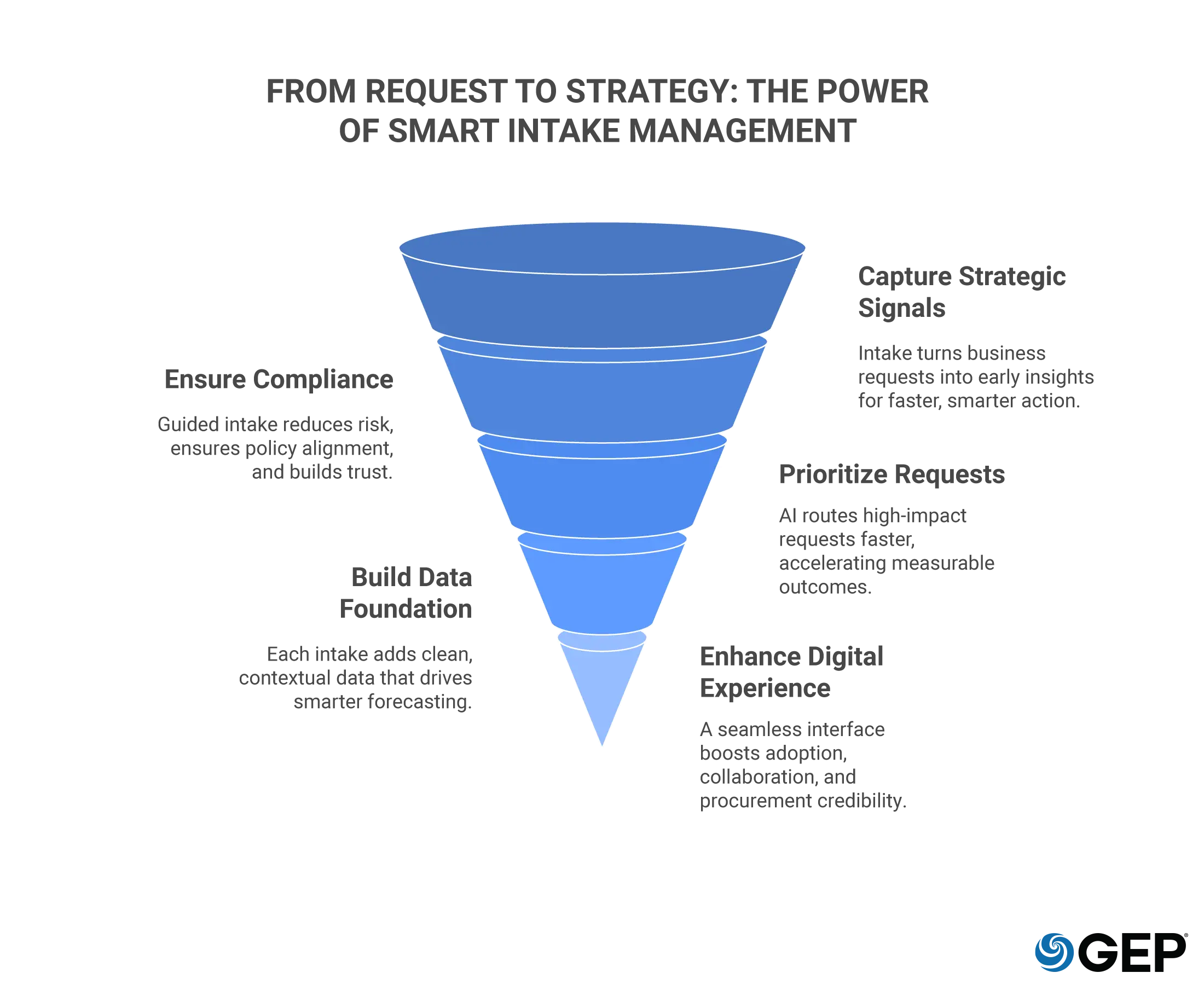
Why Intake Management Software Isn’t Just a Tool — It’s Strategic Infrastructure
- Intake is the first signal of business intent—treat it as strategic intelligence, not admin.
- A well-designed intake process builds trust, ensures compliance, and accelerates value.
- Modern intake software isn’t a workflow tool—it’s the front door to data-driven, agile procurement.
September 09, 2025 | Procurement Software 5 minutes read
If you’re in procurement or enterprise operations, you likely already know what intake management software is. You’ve perhaps piloted solutions, automated workflows, and marveled at getting rid of those infamous “request lost in email thread” scenarios. So now what?
The real question many forward-thinking companies are asking isn’t “what does intake management software do?”—but “why does it truly matter in the long game?” What if you’ve already moved past basic automation—why should you invest further? Why give intake management software more strategic mindshare?
Here’s why: Because the intake process is where intent becomes action. And in a world where business intent is constantly shifting—due to disruption, regulation, AI, geopolitical pressure, or cost control—the gateway into procurement
operations needs to be more than a compliance checklist. It needs to be intelligent infrastructure that helps your business navigate change with speed and clarity.
Let’s dig into the deeper layers of value and explore how intake management can move from tactical software to strategic enabler.
Transform intake into impact.
Talk to GEP about smarter, faster, more strategic procurement.
1. Intake Requests Are Signals of Demand — Are You Listening?
Every request logged in your system—whether it’s for a laptop, a marketing agency, or a strategic supplier partnership—is a signal.
These inputs are leading indicators of what business units need to perform, innovate, or scale. When captured well, intake data gives early insight into shifting priorities across the enterprise. When ignored or siloed, valuable foresight is lost.
A sophisticated intake platform allows organizations to treat request data like telemetry: a way to anticipate where demand is headed. For example:
- A surge in SaaS license requests might reflect scaling teams or digital transformation efforts.
- Slowdowns in capital expenditure intake may flag budget uncertainty before FP&A detects it.
Intake is often the first time business intent shows up in structured systems. Treating intake as a strategic data layer can give procurement leaders early visibility to influence strategies, align budgets, and initiate proactive sourcing—not reactive firefighting.
2. Compliance Is Boring… Until It’s Not
Yes, every intake solution boasts compliance. But let’s be honest: policy guardrails are easy to implement, hard to maintain, and often misunderstood by frontline requesters.
The real value of compliant intake goes beyond automatic flagging or routing. Strategic organizations build “compliance by design”: intelligent forms that guide rather than police, automate exceptions, and adapt based on context.
Think of it this way—what’s the cost of non-compliance?
- Hidden risks from low-visibility vendors
- Audit penalties arising from incomplete documentation
- Delayed decision-making because approvals aren’t mapped to current policy
Intake is where compliance starts—not after the PO is cut.
A policy-aware intake process has multiple benefits. It makes downstream work lighter, audits easier, and risk transparent. Also, it builds trust as stakeholders know that procurement is not the blocker—they are the enabler instead.
3. Productivity Gains Aren’t Just About Efficiency — They’re About Speed to Value
Automation is table stakes now. Digital workflows shave hours off manual processes. But if you’ve already mucked through that stage—what’s the next leap?
It’s not just speed in execution. It’s speed to outcomes. Procurement teams need to ask:
- How fast are we turning demand into value?
- Are we prioritizing needs—or are we weighing all needs equally?
- Is our intake routing helping us prioritize impact?
Modern intake systems can help you differentiate between ordinary requests and strategic asks. AI-driven prioritization, contextual routing, and dynamic SLAs make it possible to move high-value requests faster. Doing all this while efficiently managing the rest.
Efficient intake not just means faster processing. It also means deploying limited procurement bandwidth where it matters the most. The goal isn’t more requests—it’s better decisions made faster.
4. Your Procurement Data Strategy Starts Here
If you’ve invested in spend analytics, supplier dashboards, or contract lifecycle tools—you already know the value of data. But how trustworthy is that data if it lacks transparency upstream?
Intake management becomes the foundation of data quality in procurement. The shift here isn’t quantity—it’s context.
Would you rather base sourcing insights on pure historical spend—or on forecasted demand captured at the point of intake?
That means:
- Better forecasting. Align pipeline intake with supplier planning and category strategy.
- Smarter sourcing. Detect patterns in recurring requests before they become spot buys.
- Improved demand management. Rationalize overlapping needs across business units.
Intakes are not just process steps; they are structured data capture points. Done right, the data becomes a real asset—fueling predictive procurement and integrated decision support.
5. Digital Experience Is a Brand, Not a Feature
Procurement leaders often ask: “How do we drive adoption?” But that’s a narrow framing.
The right question is: “How do our stakeholders experience procurement as a service?”
Procurement, like HR or IT, has a digital touchpoint problem. If intake feels like a drag, people will go around it. If it’s elegant, smart, and helpful? People lean in.
Well-designed intake tools are more than productivity apps—they represent the brand of procurement inside your organization. They say: “We know your time is valuable. We’ve built something that works the way you do.”
The user experience of intake directly affects adoption, data hygiene, and trust. Intuitive, smart UI/UX isn’t fluff—it’s the entry point to enterprise-wide collaboration and strategic procurement.
So… What If You Already Know All This?
Great—then it’s worth asking a different kind of question: What next?
If intake management in your organization is simply a functional step—something to streamline or automate—you’ve handled the basics. But strategic organizations view intake differently. They see it as:
- A listening system for evolving business needs
- A compliance front door to eliminate downstream risk
- A triage center for prioritizing procurement bandwidth
- The first mile in a data-driven value chain
- A brand touchpoint that reflects operational maturity
This is the next horizon. One where intake is no longer invisible grunt work, but a platform investment that shapes procurement’s strategic relevance.

Do you know high-growth firms risk falling behind without AI in procurement?
Gain expert insights on closing the AI gap and driving smarter, faster procurement decisions.
Intake as a Statement of Intent
Intake isn’t just a button. It’s an opportunity—a design decision, a data enabler, and a strategic differentiator.
So, if your intake process still feels like a formality… maybe it’s time to reframe the question:
Not “what can intake software do for us?”
But “what does our intake process say about what kind of company we are—and what kind we’re becoming?”



